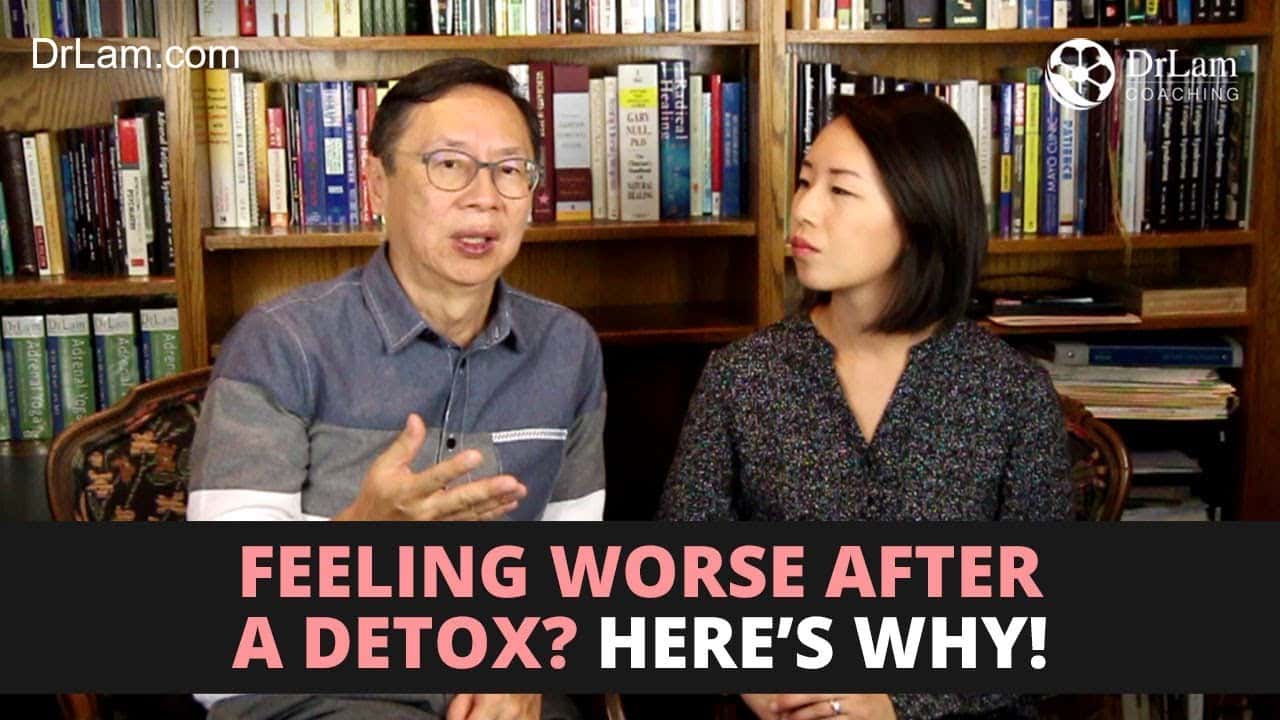
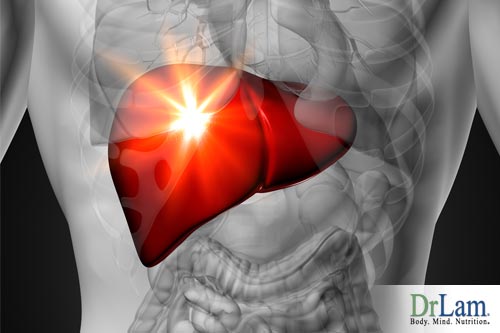 There is little doubt that our environment is polluted with toxins and harmful substances. One of the keys to optimal health is to identify useful methods of detoxification to reduce our exposure to toxic surrounding elements including our air, water and food. The reason is simple—the more toxins you have in your body, the faster you age. Toxin overload can burden our liver, triggering Adrenal Fatigue Syndrome (AFS) and retard its recovery.
There is little doubt that our environment is polluted with toxins and harmful substances. One of the keys to optimal health is to identify useful methods of detoxification to reduce our exposure to toxic surrounding elements including our air, water and food. The reason is simple—the more toxins you have in your body, the faster you age. Toxin overload can burden our liver, triggering Adrenal Fatigue Syndrome (AFS) and retard its recovery.
The concepts of internal cleansing and detoxification have been around for centuries. Detoxification of the body refers to the cleansing of the bowels, kidneys, lungs, the liver and the blood since these are the organs involved in the detoxification of chemicals and toxins from the body.
A toxin is defined as any compound that has a detrimental effect on cell function or structure.
Toxins can damage the body in an insidious and cumulative way. Fortunately, the body has a built in detoxification process working 24/7. However, once the internal detoxification system becomes overloaded, toxic metabolites begin to accumulate within. It is this accumulation of toxins over a period of time that can wreak havoc on our normal metabolic processes because the body has to work extra hard to get rid of it. As our body’s workload increases, we can then become progressively more sensitive to other compounds, including nutrients and drugs, some of which are normally non-toxic.
Toxins include industrial chemicals and their polluted by-products, pesticides, additives in our foods, heavy metals, anesthetics, drug deposits, environmental hormones, and secondary smoke. More than two million synthetic substances have been identified and 25,000 new toxins are added each year. About 30,000 are produced on a commercial scale. Unfortunately, only a minuscule percentage is ever tested for toxicity.
These can be broadly classified into the following categories:
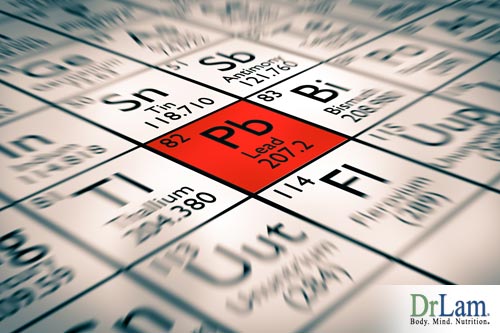 Lead, mercury, cadmium, arsenic, nickel, and aluminum are included in this category. These metals tend to accumulate in the brain, kidneys and immune system.
Lead, mercury, cadmium, arsenic, nickel, and aluminum are included in this category. These metals tend to accumulate in the brain, kidneys and immune system.
Up to twenty-five percent of the US population suffer from heavy metal poisoning especially from lead, mercury, and aluminum. Over 600,000 tons of lead is released into the atmosphere from industrial processes and leaded gasoline. The toxins can then either be inhaled or ingested after being deposited on food crops, fresh water and soil.
Heavy metal toxicity has been linked to several diseases including Alzheimer’s disease, Parkinson’s disease and severe neurological disorders.
Other common sources of heavy metals include lead from pesticide sprays and cooking utensils; cadmium and lead from cigarette smoke; mercury from dental fillings, contaminated fish, and aluminum from antacids, cookware, and soda cans.
The early signs of heavy metal poisoning are vague or often attributed to other diseases. The early symptoms of heavy metal poisoning include headaches, fatigue, muscle pain, indigestion, tremors, constipation, anemia, and indigestion. Mild toxicity symptoms include impaired memory and distorted thinking ability. Severe toxicity can lead to death.
The most accurate measurement of toxins in the body is by blood analysis of actual toxin levels of each toxin within the red blood cells. Many toxic metals have a tendency to accumulate inside the cell where most of the damage is done. Serum toxic metal levels do not correlate well with intracellular toxic metal levels.
For those who are healthy, a good detoxification program includes chelation therapy using EDTA to bind toxic metals, high potency multiple vitamin and mineral supplementation, sulfur-containing amino acids (methionine, cysteine, and taurine), and high sulfur-content foods such as garlic, onion and eggs and water-soluble fibers such as guar gum, oat bran, pectin and psyllium seed. Natural component such as barley grass, spirulina, chlorella, and sea vegetables also have good chelation property and can be considered. Note that those who have AFS generally do not do well on such programs. The more advanced the AFS, the less effective this is and the higher the probability of failure. In some cases, such detoxification programs can trigger adrenal crashes because the body is too weak to tolerate such an approach.
The liver is the major detoxification center of the body. It acts as an in-line filter for the removal of foreign substances and wastes from the blood. Toxins that are cleared by the liver include alcohol, solvents, drugs, binders and fillers from nutrition supplements, formaldehyde, pesticides, herbicides and food additives. Despite varying chemical toxicities, the liver has the function of reducing toxins into compounds that the body can safely handle and remove through the kidneys (as urine), skin (as sweat), lungs (as expelled air) and bowels (as feces). Optimal liver function is therefore essential for good health.
The symptoms of a compromised liver include psychological and neurological symptoms such as depression, headache, mental confusion, fatigue, anxiety, joint pain, mental illness, brain fog, abnormal nerve reflexes and tingling in the hands.
The solution is to take compounds that support the liver’s detoxification mechanism. Such compounds include milk thistle extract, choline, methionine, glutathione, N- acetyl cysteine, and lipoic acid. Again, those with AFS need to proceed with care, as the body may not be able to tolerate these compounds, even though they are natural. The right compounds, timing, and delivery system is key to avoid unexpected symptoms of retoxification from this attempt to rid toxins from the liver.
Toxins produced by unwanted bacteria and yeast in the gut can be absorbed which can cause a significant disruption of bodily functions. Examples of such toxins include endotoxins and exotoxins from bacteria, toxic amines, toxic derivatives from bile and many carcinogens. These toxins have been implicated in many diseases including Crohn’s disease, IBS, leaky gut, ulcerative colitis, psoriasis, lupus, pancreatitis, allergies, asthma, immune disorders, and delayed food sensitivities.
In addition, antibodies formed against microbial molecules (antigens) can cross-react with the body’s own cellular structure. This in turn causes autoimmune diseases such as rheumatoid arthritis, myasthenia gravis, diabetes and autoimmune thyroiditis.
The solution is to follow a diet rich in fiber, particularly water-soluble fibers such as those found in vegetables, guar gum, pectin and oat bran. Fiber has the ability to eliminate toxins from the gut and promote their excretion. The replacement of healthy bacteria such as acidophilus is also helpful.
The kidneys are mainly responsible for the elimination of toxic waste products from protein breakdowns such as ammonia and urea.
For those who are healthy, detoxification of the body involves cleansing the kidneys with adequate amounts of water (at least 8 to 10 glasses a day) and a reduction in protein intake (such as red meat) to avoid overloading the body with urea, which is a result of the breakdown of protein. Those with AFS may need to add salt to the water to aid electrolyte balance. Excessive protein reduction may make matters worse in advanced cases of AFS where the body is already in a catabolic state.
Most of us cannot escape to a safe haven, free from toxins and pollutants. The air that we breathe is polluted, the water that we drink is full of chlorine, the clothing we wear is made of artificial fabrics and chemicals, the lotions and shampoos that we use all contain chemicals. Once these chemicals are inside us, we can never fully eliminate them unless we undergo a detoxification process. As a result, most of us need some form of detoxification.
Our bodies are clearly designed to be self-cleansing and self-healing. The internal detoxification process is an automatic daily procedure by the major detoxification organs. In the past, detoxification was for reformed alcoholics and drugs addicts, people with severe allergies, cancer patients. Nowadays healthy individuals wishing to maintain the most pristine of conditions within their body’s systems adopt this process.
A weekly, monthly or even quarterly detoxification program can make a big difference in optimizing the bodily functions. In fact, it might even help prevent chronic opportunistic diseases such as cancer, diabetes, chronic fatigue and arthritis.
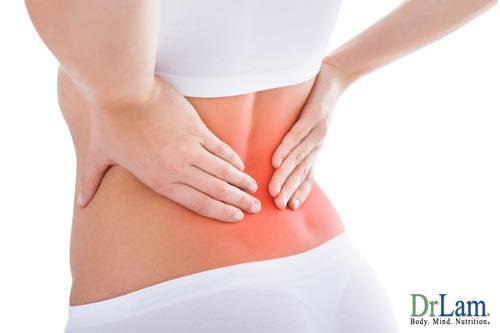
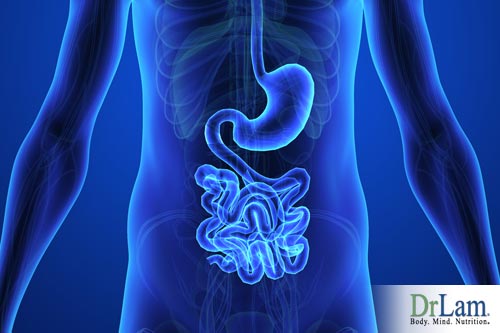
So, what should you know about your liver in detoxification mode if you have adrenal fatigue syndrome? Keep reading to find out. The more advanced the adrenal fatigue, the more care should be considered before embarking on any form of detoxification therapy including a liver in detoxification. The reason is simple. The weaker the body (as in advanced stages of AFS), the more congested the detoxification organs. These include the liver, kidneys, and the skin. Too aggressive a detoxification program can lead to massive release of internal toxins that the body is unable to excrete on a timely basis. A liver in detoxification that is too intense may result in ill affects and negative results. This can lead to a variety of unpleasant side effects, including fatigue, anxiety, brain fog, heart palpitations, fever, dizziness, hypoglycemia, insomnia, feeling wired, joint pain, ringing in the ears, nausea, vomiting, diarrhea, chills, and tingling sensations, just to mention a few.
A number of natural greens are proven to effectively remove noxious substances from the body without further upsetting its delicate balance in such cases. This may be considered for those in advanced stages of AFSif the dosage is titrated properly. Here are a few of the more popular, natural cleansing substances available.
As it happens, the popular culinary herb cilantro (also known as coriander and Chinese parsley), is also one of the most dependable natural detoxifiers known, especially effective in removing mercury, heavy metals, and other toxic contaminants from the body. Available in juice, fresh, or dried forms (found at most health food suppliers), cilantro can simply be added to your diet as seasoning.
A single-cell, fresh-water green algae scientifically proven to bind with mercury, lead, and cadmium, chlorella is superior in safely drawing out toxic metals that accumulate in the gut and intestinal tract. High in protein and other essential nutrients, advocates of chlorella claim that in using it as a dietary detoxifier, it has the added benefits of helping control weight, supporting the immune system, and even preventing cancer. Be mindful that too much chlorella introduced into the body too quickly can produce unpleasant side effects — gas, bloating — primarily in the digestive tract. So, begin with a relatively low quantity and slowly increase to achieve a gentle detox.
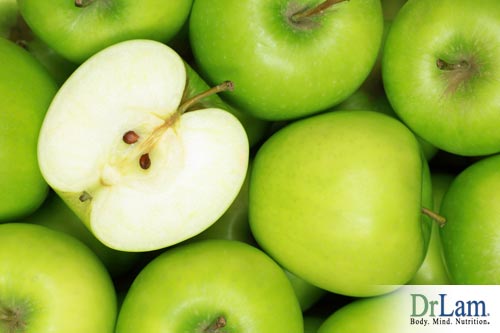 Many people find fruit pectin to be the gentlest natural substance for ridding the body of harmful contaminants. Derived from fruits high in pectin such as green apples, and the white part of citrus fruit—as well as bananas, grapes, carrots, beets, okra and cabbage—pectin has been shown to draw heavy metals, toxic chemicals, and other substances into the blood stream where they can be carried from the body (with the urine).Pectin can be introduced into the body simply by eating plenty of pectin-rich fruits and vegetables, or by adding a processed pectin product to a glass of water, organic grape juice, or fresh veggie juice—which can help speed the detox process. (Beware of pectin sold in grocery stores as some brands contain MSG.)
Many people find fruit pectin to be the gentlest natural substance for ridding the body of harmful contaminants. Derived from fruits high in pectin such as green apples, and the white part of citrus fruit—as well as bananas, grapes, carrots, beets, okra and cabbage—pectin has been shown to draw heavy metals, toxic chemicals, and other substances into the blood stream where they can be carried from the body (with the urine).Pectin can be introduced into the body simply by eating plenty of pectin-rich fruits and vegetables, or by adding a processed pectin product to a glass of water, organic grape juice, or fresh veggie juice—which can help speed the detox process. (Beware of pectin sold in grocery stores as some brands contain MSG.)
Adding wheatgrass (available in either juice or powder form) or barley grass/leaf (available primarily in powder and capsule form) to freshly juiced fruits or vegetables is an ideal way to remove toxins from the body.While wheatgrass is unquestionably high in vitamins, minerals, and all nine essential amino acids — and a very effective natural detoxifier — advocates report that barley grass is generally easier on the digestive tract, and has the added benefit of being high in organic sodium and therefore beneficial to those with arthritis symptoms. Accordingly, if you choose to use wheatgrass, start with a small amount (1/2 ounce per day) and increase as the body permits.
(Note: Bear in mind that using any detoxification agent requires repeated or prolonged use over a period of time until all symptoms have dissipated. And even when utilizing a gentle, all-natural substance, side effects may include nausea, vomiting, muscle aches and pains, dizziness, and fatigue. Additionally, detoxification can cause a temporary flare-up of your symptoms — this simply indicates that toxins are being flushed from your system—and normally passes relatively quickly. However, if side-effects become severe, reduce the quantity of whichever detox agent you're using, and should symptoms persist, consider a different detoxifier or consult a natural health practitioner for advice.)
Here is a list of foods that the AFS sufferer should consider for liver support. Bear in mind that the body’s ability to tolerate these foods is highly dependent on the stage of Adrenal Fatigue Syndrome (AFS). Typically, the more advanced the AFS, the less the body is able to tolerate these foods, even though they may be good for the liver. Always consult your health care practitioner before embarking on this diet if you are an AFS sufferer.
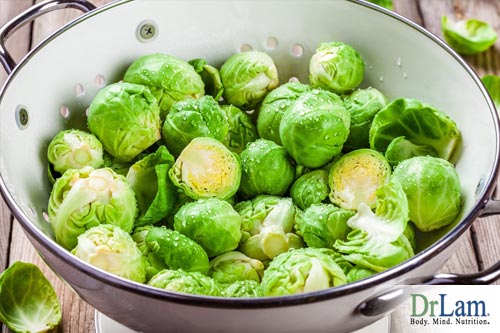 There are many ways of taking in more sulfur. Cooked vegetables offer generous quantities of non-protein bound sulfur and cruciferous vegetables like sprouts, cabbage, broccoli, bok choy, kale, Brussels sprouts and cauliflower are good sources. Red radish, turnip, daikon root, rutabaga, collard greens, Napa cabbage, mustard greens along with garlic and onion are other foods that offer nonprotein bound sulfur. While the above list is acceptable for normal healthy people, those with AFS need to be more careful. Why? Because most sufferers of AFS have some degree of estrogen dominance and their ovaries and thyroid are usually off balance. Goitrogenic foods including cruciferous vegetables such as broccoli or cauliflower should therefore be taken in moderation and in cooked form.
There are many ways of taking in more sulfur. Cooked vegetables offer generous quantities of non-protein bound sulfur and cruciferous vegetables like sprouts, cabbage, broccoli, bok choy, kale, Brussels sprouts and cauliflower are good sources. Red radish, turnip, daikon root, rutabaga, collard greens, Napa cabbage, mustard greens along with garlic and onion are other foods that offer nonprotein bound sulfur. While the above list is acceptable for normal healthy people, those with AFS need to be more careful. Why? Because most sufferers of AFS have some degree of estrogen dominance and their ovaries and thyroid are usually off balance. Goitrogenic foods including cruciferous vegetables such as broccoli or cauliflower should therefore be taken in moderation and in cooked form.
Protein bound sulfur is also essential and the best foods for that are egg yolks and meat. One or two soft-boiled eggs daily can offer sufficient protein bound sulfur. The more advanced the AFS, the less tolerable egg yolks are to many when the yolk is well cooked. Those in this category can take poached or properly cleaned raw egg instead.
Lack of folic acid is linked to liver injury due to a hampered ability to mobilize the essential amino acid methionine, which your liver needs for normal metabolism and fat lipid oxidation.
There are many foods that are generously rich in folic acid including egg yolks, soy, liver and kidney, split peas, almonds, lentils, sweet potatoes, dried soybeans, asparagus, beetroot, oranges and peaches. And if you have ovarian-adrenal-thyroid (OAT) axis imbalance commonly seen in advanced stages of AFS, avoid soy.
Niacin, also known as Vitamin B3, is a water-soluble vitamin that can cleanse the blood, the lymph system, and the liver. Niacin can break down the fat cells where toxins are kept which will then be carried out of the body. Large amounts of niacin can be toxic and cause uncomfortable reactions such as flushing or reddening of the skin as well as an upset stomach so always consult your healthcare practitioner before embarking on a high dose niacin detoxification program.
As sixty percent of all the B12 in the liver (thirty percent of all the B12 in the body) is in the mitochondria of the liver powering the cells to do their job it is clear how low B12 levels could potentially damage the liver.
Vitamin B12 can be obtained from meat (poultry is ideal), cooked fish (especially sockeye salmon, haddock, rainbow trout and white tuna) and whole egg. The problem with B12 in an AFS setting is that this vitamin tends to be quite stimulating. Sufferers may be addicted to an ever-increasing amount in order to stay energized over time, resulting in a state of wired and tired. Reduction can be very problematic due to addiction as well as unpleasant withdrawal symptoms that can trigger adrenal crashes.
Vitamin B6, along with niacin, helps the liver create energy. Vitamin B6 also aids the liver in removing toxins and excess hormones in the body. Vitamin C and E, when taken together, may assist people with fatty liver disease.
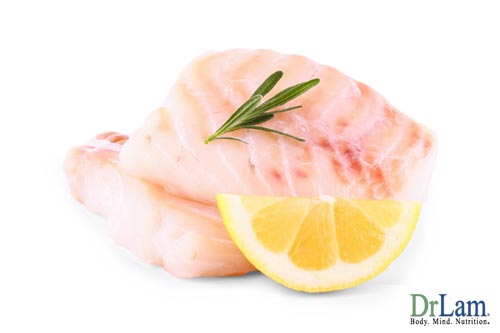 Betaine can be obtained from foods that are rich in choline. Eggs, cod, beef liver, toasted wheat germ, Brussels sprouts, broccoli, salmon and shrimp.
Betaine can be obtained from foods that are rich in choline. Eggs, cod, beef liver, toasted wheat germ, Brussels sprouts, broccoli, salmon and shrimp.
The correct form of selenium is important in the glutathione synthesis and breakdown of certain toxic compounds in the liver. Sardines, blue corn, organic yellow corn, anchovies and herring are the common sources for selenium.
An excellent way to develop good health and toxin cleansing is by juice fasting. This is because juices, without their pulp (fiber), contain excellent sources of vitamins, minerals and enzymes. One can readily drink the juice of several heads of lettuce at one go but may not be able to consume the same amount of lettuce as a whole. Juices also contain good sources of antioxidants and enzymes needed for toxin cleansing and excretion. At the same time, they are easy to digest and thus can help to eradicate digestive problems. As a result, drinking juices allows the body to receive plenty of nutrients with minimal digestive action needed. Moreover, fasting on mono-juices allows the body to have sufficient time to process these juices and valuable digestive enzymes can be preserved. During fasting, a sense of well-being, renewed energy, clearer thoughts and cleaner body systems can result.
Fruit juices are very different from vegetable juices. Fruit juices should be avoided as the high sugar content of fruit juice raises blood sugar and insulin levels and are not as helpful to a liver in detoxification. This can lead to insulin resistance and ultimately diabetes in the long run. Many AFS sufferers have subclinical reactive hypoglycemia. Fruit juices can worsen the condition.
Vegetable juices are not as pleasant-tasting as fruit juices. The beginner should begin by gulping the juice, as this is probably the best way to get started. This process will ensure that the juice is in minimal contact with the taste buds. Start slowly by drinking only one or two ounces and finally up to 12 ounces each time. Too much vegetable juicing may trigger adrenal crashes. Always consult your doctor before you start.
Eat some vegetables before, during or after the vegetable juicing. The chewing motion will stimulate gastric juice secretion and aid digestion. It is also important to do some chewing during juicing.
As vegetable juicing is not a natural phenomenon in modern day society, the body will need some time to adapt. It is important to pay heed to your body's signals on which vegetable juices to consume and which types to continue in small amounts.
The pulp is one of the best parts of the juice although its palatability leaves much to be desired. It adds bulk and fiber to your diet and helps bowel movements. Try mixing ten percent of the pulp back into the juice and slowly increase the amount in accordance with your tolerance level. Very few people can consume all the pulp juice as it is quite thick and would look like a bowl of porridge instead of a glass of juice.
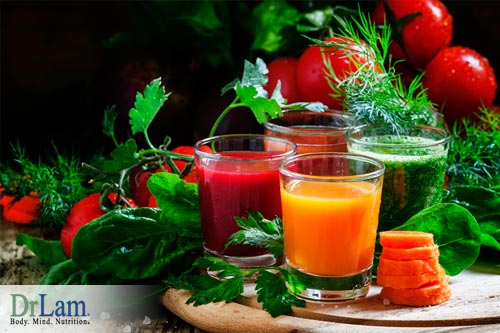 All vegetable juices should be consumed immediately. Vegetable juice is one of the most perishable foods. Do not keep for more than 24 hours. Storage is tricky. Oxidation should be prevented. If you have to keep the juice, put it in a glass jar with an airtight lid and fill it to the brim to minimize air space. The oxygen in the air (remember air contains twenty percent oxygen) will oxidize and damage the juice. Wrap the jar with aluminum foil to block out all light, which would also damage the juice and then store it in the refrigerator. The juice should be taken out of the refrigerator 30 minutes prior to consumption, as it should ideally be consumed at room temperature.
All vegetable juices should be consumed immediately. Vegetable juice is one of the most perishable foods. Do not keep for more than 24 hours. Storage is tricky. Oxidation should be prevented. If you have to keep the juice, put it in a glass jar with an airtight lid and fill it to the brim to minimize air space. The oxygen in the air (remember air contains twenty percent oxygen) will oxidize and damage the juice. Wrap the jar with aluminum foil to block out all light, which would also damage the juice and then store it in the refrigerator. The juice should be taken out of the refrigerator 30 minutes prior to consumption, as it should ideally be consumed at room temperature.
The beginner should start with celery, fennel (anise) and cucumber. These vegetables may not be the most nutritious but at least they are more tolerable and palatable than others when embarking upon the initial process for your liver in detoxification.
Once the beginner is used to the taste of vegetable juices, other recommended vegetables include spinach, Swiss chard, beet greens, cabbage, bok choy, arugula, endive and lettuce.
Herbs can also be added to juices such as parsley and cilantro.
The advanced juicer wanting to put their liver in detoxification mode should try collard greens, dandelion greens and mustard greens, as these vegetables are very beneficial. These greens are quite bitter tasting.
To make your juice more palatable to your mouth and your liver in detoxification, you can also add small quantities of carrots and beets. These vegetables are relatively high in sugar content compared to their green leafy counterparts. Coconut is another option to improve the taste of vegetable juices. They are also a good source of fat to balance the meal. Improper or excessive juicing can trigger adrenal crashes. Consult your health practitioner before embarking on any juicing program.
Juicing with the right juicer is important. The heat generated from an ordinary juicer can destroy precious antioxidants quickly. A good all-around slow juicer such as Omega VRT350 is recommended.
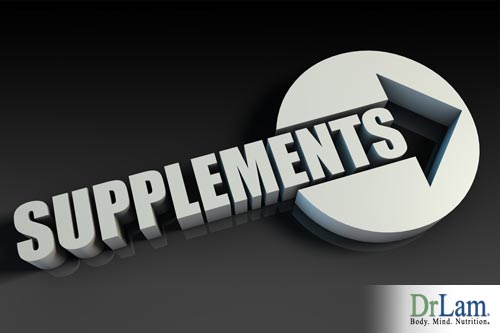 The process of detoxification is one that can be difficult for many. To be successful many people think it is necessary to starve in order to triumph in the process of detoxification. Well, this isn't completely true. As detoxification diets may not stimulate the liver, lungs or the kidneys enough, herbal detoxification supplementation is often added. Not only do herbs provide vitamins, minerals and enzymes—essential for good nutrition, they are also useful in helping certain organs when different herbs are combined. Different herbal combinations aid the process of detoxification and they can be found in most organic food stores .
The process of detoxification is one that can be difficult for many. To be successful many people think it is necessary to starve in order to triumph in the process of detoxification. Well, this isn't completely true. As detoxification diets may not stimulate the liver, lungs or the kidneys enough, herbal detoxification supplementation is often added. Not only do herbs provide vitamins, minerals and enzymes—essential for good nutrition, they are also useful in helping certain organs when different herbs are combined. Different herbal combinations aid the process of detoxification and they can be found in most organic food stores .
The liver is the main detoxification center of the body. In the process of detoxification, a detoxification regimen should include cleansing and protecting the liver. There are a wide variety of plants that exert beneficial effects on liver function during the process of detoxification.
The most impressive research done, looking at the process of detoxification, has been done on a special extract of milk thistle (Silybum marianum) known as silymarin, a group of flavonoid compounds. These compounds protect the liver from damage and enhance the detoxification process.
Silymarin prevents damage to the liver by acting as an antioxidant. It is much more effective than vitamin E and vitamin C. Numerous research studies have demonstrated its protective effects on the liver. Extremely toxic chemicals such as carbon tetrachloride, amanita toxin, galactosamine and praseodymium nitrate produce experimental liver damage in animals. Silymarin has been shown to protect the liver against these toxins.
Silymarin also works by preventing the depletion of glutathione. The higher the glutathione content within cells, the greater the liver's capacity to detoxify harmful chemicals. Moreover, silymarin has been shown to increase the level of glutathione by up to thirty-five percent. In human studies, silymarin has been shown to exhibit positive effects in treating liver diseases of various kinds including cirrhosis, chronic hepatitis, fatty infiltration of the liver, and inflammation of the bile ducts. The common dosage for silymarin is 70 to 200 mg one to three times a day. Milk thistle comes in different forms. Fermented milk thistle, for example, is an excellent way, but only if properly used.
For effective detoxification, herbs should be used in conjunction with the detoxification diet.
A healthy intestine is of paramount importance for AFS recovery. Optimal gastrointestinal health depends on the balance of microscopic interplay between billions of beneficial (good) and pathogenic (bad) bacteria. Both are needed for normal bowel function. A well-maintained balance between these opposing microorganisms is essential for a properly functioning digestive tract.
About 400 species of these good bugs inhabit the intestines. Their total population is about 100 times the number of cells in your body. Remarkably, these microorganisms coexist peacefully in a carefully balanced internal ecosystem. As long as they flourish, they prevent pathogenic (disease-causing) bacteria and fungi from colonizing. In this way, beneficial bacteria help keep you healthy. If the delicate intestinal environment is disrupted, pathogenic bacteria, parasites and fungi such as clostridia, salmonella, staphylococcus, Blastocystis hominis and Candida albicans often move in, multiply and attack the beneficial bacteria.
Research has shown that the good bacteria or otherwise known as probiotics, help defend the body from the pathogenic species of bacteria and detoxify toxic chemicals.They also produce valuable vitamins including biotin, folic acid, niacin, pantothenic acid, riboflavin, thiamin, vitamin B6, vitamin B12 and vitamin K. The bacteria assist in breaking down dietary proteins into amino acids, which are then reconfigured into new proteins that are useful for the body. The good bacteria also ensure that toxins are excreted from the bowels (via the stool) rather than absorbed into the bloodstream.
One such good bacteria is acidophilus. They stimulate activity in the thymus and spleen (both are key immune system glands). They prompt your body to manufacture natural antibodies. Certain acidophilus strains even protect against the formation of tumors and promote the production of interferon, a hormone that protects against cancer. When probiotics are present, they secrete mediators in which the pathogenic forms cannot grow. However, when the micro-organic forms take over, they will exclude the probiotics with their toxins. Replacing our natural flora is vital to prevent any disease and to keep our bowels healthy and populated with probiotics. By taking probiotics containing Lactobacillus acidophilus and Bifidus, they can help us in our detoxification program.
Numerous studies have been conducted to understand the mechanism of how probiotics work. Many amazing facts have been established concerning the beneficial and therapeutic aspects of probiotics including:
Many scientists at the forefront of probiotics research believe that the toxins secreted from the pathogens, rather than the pathogens, are responsible for diseases
Regular supplementation with probiotics such as acidophilus repopulates your intestinal tract with benevolent bugs. These microorganisms restore and maintain balance within your internal ecosystem while displacing noxious bacteria and fungi at the same time. They also increase the acidity of the intestinal environment, which useful bugs thrive in (acidophilus literally means love of acid) and harmful bugs detest.
Probiotics also have another benefit if the intestines are not inhabitable for the malevolent microorganisms: They help reduce a number of toxic chemicals in the body, namely pathogenic bacteria and fungi, which produce their own toxins. At a local level, this minimizes the risk of colon cancer and protects the entire body and improves overall health on a larger scale.
Acidophilus supplements are widely available in health food stores and drugstores. Selecting from among the numerous something-dophilus products may appear a daunting task. Examine the labels and you will discover a variety of useful bugs including Lactobacillus acidophilus, Bifidobacterium bifidum, Bifidobacterium Longum, Bifidobacterium Breve, Lactobacillus Thermophilus, Lactobacillus Casei, Lactobacillus bulgaricus and Streptococcus faecium. Some products may contain fructo-oligosaccharides, which are sugars that nourish beneficial bacteria to make them colonize faster. All of these ingredients are acceptable and any combination of them works well.
Remember that acidophilus supplements contain living organisms, so freshness is critical. Purchase a product well before its expiration date, which should be clearly displayed. Once the supplements are opened, keep them refrigerated. Discard any supplements that are more than six months old. Dosage varies from one product to another. It is best to refer to the instructions on the label.
If you do not wish to consume supplements, try yogurt, which contains the friendly bacterium Lactobacillus acidophilus, a probiotic. Acidophilus also helps restore intestinal micro flora balance and inhibits the growth of bad bacteria. In a nutshell, probiotics promote good digestion, boost immune function, increase resistance to infection and keep us better equipped to fight the growth of disease-causing bacteria.
Caution: Excessive probiotics use can lead to constipation.
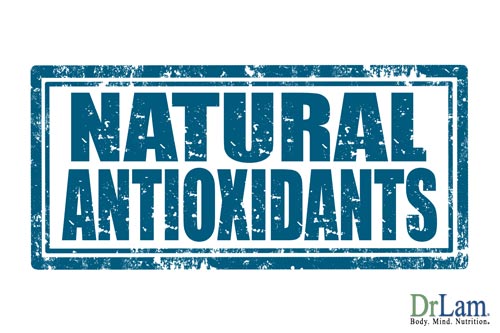 Antioxidants such as vitamins A, E, and glutathione are essential for detoxification as they help cells to neutralize free radicals that cause mutation and cellular damage. When these free radicals are neutralized, the antioxidant vitamins will be utilized and display low levels. They play such an important role that any deficiency in them is detrimental to anti-aging. When our antioxidants are low, energy is unavailable and detoxification cannot take place as usual. This allows the toxins to multiply and add up until they can be further processed. Our liver and other organs are also compromised in their functions. With a simple deficiency in energy, health can be threatened since its energy has been diverted to the removal of toxins and waste.
Antioxidants such as vitamins A, E, and glutathione are essential for detoxification as they help cells to neutralize free radicals that cause mutation and cellular damage. When these free radicals are neutralized, the antioxidant vitamins will be utilized and display low levels. They play such an important role that any deficiency in them is detrimental to anti-aging. When our antioxidants are low, energy is unavailable and detoxification cannot take place as usual. This allows the toxins to multiply and add up until they can be further processed. Our liver and other organs are also compromised in their functions. With a simple deficiency in energy, health can be threatened since its energy has been diverted to the removal of toxins and waste.
Taking optimum levels of antioxidants during fasting is important and an effective way to raise glutathione levels in the liver. They should be taken together with silymarin, the flavonoid complex from milk thistle, to improve liver function. Glutathione and silymarin are both important detoxification agents of the body.
Vitamins should be taken as a cocktail in optimum amounts because each vitamin is unique and works on a different aspect of the body. For example, both vitamins A and E are fat-soluble and are found in our fat tissues/ stores. They are particularly effective in preventing the oxidation of cell membranes, which are made up of phospholipids.
On the other hand, vitamin C is water-soluble and fights free radicals in the plasma. Vitamin C and E help regenerate each other as well.
High doses of vitamin C can have a laxative effect as it attracts water. Vitamin C can be taken until a bowel tolerance level (BTL) is achieved. The BTL varies from one person to another. Some people may reach a tolerance level at four to five grams (4,000 - 5,000 mg) while others only reach tolerance at 10 to15 grams (10,000 - 15,000 mg). Cancer patients can easily consume 20 to 30 grams (20,000 - 30,000 mg) of vitamin C to reach the tolerance level, as they require more vitamin C than most people. The body's ability to tolerate vitamins depends on the state of AFS. The more advanced the AFS, the lower the tolerance, and the less assimilated. This is common. Always talk to your practitioner before embarking on such a program if you have AFS.
Glutathione is an antioxidant that can aid in gentle detoxification as it attaches to the wastes within the body and draws them out. Unfortunately, if taken orally, glutathione has a very poor absorption rate. One way for the body to fully utilize glutathione is intravenous, however, this can be costly. Liposomal glutathione is a very good alternative as it is as well absorbed as intravenous with a much lower cost.
Other helpful nutrients that should also be considered include quercetin and acerola as well as extracts of resveratrol, green tea, grape seed, red wine, and bilberry.
Enzymes are molecule catalysts located in abundance in the body. In fact, there are over 1,300 different types. Enzymes are considered the construction workers that facilitate all the bodily functions.
There are several forms of enzymes. Raw fruits and vegetables contain a plentiful supply of enzymes. Cooking and processing food can destroy enzymes. When enzymes are destroyed, the body's ability to digest food, deliver nutrients and maintain optimum functions are affected. Toxins thus build up and accumulate in the body. Some of these enzymes are amylase, lipase, lactase, protease, and cellulase.
Digestive enzymes are especially important, as exhaustion is one of the main reasons for accelerated aging. Plant enzymes assist in the digestion of food directly through the intestinal tract. Supplemental enzymes help prevent bloating and exhaustion after a large meal. We consume an average of two pounds of food per day or 20 tons over a lifetime. Smooth passage of food through the gastrointestinal tract is critical to avoid stasis of feces, which releases toxins. Digestive enzymes help in this respect together with a high soluble fiber diet. A good blend of nutrients should include amylase, lipase, protease, cellulase, ginger root, papain, raisin powder, pectin, and beta glucan.
Digestive enzymes also help other vitamins and minerals. For example, fat-soluble vitamins A, D, E, and K require fat for absorption. Fat has to be broken down by an enzyme known as lipase. If lipase is not present in sufficient quantities, the fat will not be broken down. If the fat is not broken down, the vitamins will not be released. Therefore, you can spend a fortune on vitamin pills but if there is an absence of the proper enzymes to release the vitamins into the body's systems, the vitamins will still be flushed out.
On an interesting note, one of the early signs of improved digestion following digestive enzyme consumption is an improvement in skin tone. Likewise, if the inner organs start to degenerate and fail to function properly, the stress will most likely be revealed on the face. Supplementation with digestive enzymes is, therefore, an important part of an anti-aging treatment, in addition to consuming raw foods and mineral supplements.
Caution: Excessive enzymes can lead to loose stools or diarrhea.
How can charcoal help in the process of detoxification? Charcoal has been used as a natural remedy for centuries and different delivery systems have been made available through modern technology. Because of its adsorption capabilities, charcoal has been used for indigestion, food poisoning, bloating, and detoxification. Charcoal can be ingested or can be made into poultices, wraps, braces, lotions, soaps, and garments. Clothes made out of charcoal cloth are particularly useful. For those with advanced AFS, charcoal apparel can be an excellent option for gentle detoxing. There are many options available according to each person's sensitivity. The construction of the apparel and the application length of time are critical determinants of success.
What can geranium do to help in the process of detoxification? Well, germanium is a gray-white semiconductor element that may help relieve inflammation if applied externally. Germanium atoms attract harmful positive charge ions from the body and help balance the ions within the body. It also has an additional effect in helping the body's muscles relax, reducing fatigue and tiredness while increasing circulation and enhancing the body's anti-inflammatory defense system. For those with AFS, the body slows down and becomes easily inflamed. Germanium apparel may be a gentle option to help rebalance the positive and negative charge ions within the body that have been thrown off by its own equilibrium.
Germanium has two important distinguishing factors that bring about healthy functioning effects in the human body. These traits are its inherent ability to balance the body's ions, also known as bioelectricity, and its ability to penetrate far infrared rays into the human body.
Our modern lifestyle frequently exposes the body to harmful positive charge ions, usually generated from mobile phones, computers, various other electronic equipment, chemicals and ultraviolet or UV rays. The presence of more positive charge ions makes the body operate more slowly and much less efficiently. The cells within the human body start to weaken, making it more susceptible to aging and illness. This process commonly accelerates due to a lack of oxygen reaching blood cells with a now reduced carrying capacity.
So, let's explore infrared rays in the process of detoxification. A far infrared ray is an element of sunlight, a type of energy wave. These rays contain an incredibly low amount of energy that subsequently provides no detrimental effects on human bodies. It's also not considered a radioactive ray. The human body is naturally considered organic. It's also a source of far infrared rays. This fact relates to the ancient Chinese art of chi, which implies humans harbor their own internal life force, which works much like the previously mentioned rays.
Far infrared rays, although not considered radioactive, have similar characteristics to sources of light with radiation elements. Light energy, in general, doesn't require additional mediums or conductors to transmit energy to objects. The light from the Sun, as an example, travels incredibly long distances without other mediums to Earth.
Far infrared rays do share different traits apart from normal visible light. Far infrared rays can travel or penetrate through objects. These rays can travel as deep as four to 10 centimeters from the top layer of human skin into the body, essentially warming the body from the inside out.
Studies have been conducted on the effect of far infrared therapy or stimulation to improve blood flow, which as a result may affect wound healing, or patients undergoing hemodialysis.
Germanium can emit a certain amount of far infrared rays, measuring around four to 14 microns. When both the body and germanium emit the same nine-micron wavelengths, this overlapping causes the water molecules within the body to warm, facilitating the circulation of blood throughout the body. As the body contains over seventy percent water in weight, this process essentially reactivates the body's water molecules, which in turn, improves blood circulation.
When far infrared rays get absorbed into other parts of the body, such as organs, it potentially revitalizes, improves and strengthens them. This process also increases the temperature underneath the skin, in addition to promoting micro-circulatory flow throughout the body, improving overall health.
In the process of detoxification, there are numerous detoxification modalities available in addition to what is presented in this paper. Some unique ingredients in the process of detoxification can include the use of activated charcoal, germanium, or combinations of them unique
 Other modalities, in the process of detoxification, include acupuncture and acupressure to open up the meridian, lymphatic massage and stimulation to increase toxic excretion, various forms of baths and soaks, gallbladder and liver cleanses or flushes to clear out heavy metals, parasites, and internal toxins; anti-Candida herbs to lower intrinsic toxic load, pulse electromagnetic field therapy to rebalance internal energy flow, various forms of hyperthermia modalities including the use of sauna and far-infrared rays, intravenous ozone and hydrogen peroxide therapy are also helpful in the process of detoxification.
Other modalities, in the process of detoxification, include acupuncture and acupressure to open up the meridian, lymphatic massage and stimulation to increase toxic excretion, various forms of baths and soaks, gallbladder and liver cleanses or flushes to clear out heavy metals, parasites, and internal toxins; anti-Candida herbs to lower intrinsic toxic load, pulse electromagnetic field therapy to rebalance internal energy flow, various forms of hyperthermia modalities including the use of sauna and far-infrared rays, intravenous ozone and hydrogen peroxide therapy are also helpful in the process of detoxification.
While each specific modality has its benefits when deployed at the right time with the right intensity, indiscriminate use can often make Adrenal Fatigue Syndrome recovery worse. Those who are in mild AFS may experience a temporary increase in energy during detoxification, but it is often short-lived so that continuous and higher intensity treatment is often required. Prolonged use can lead to a state of dependency and feel wired and tired. For those who are in advanced stages of AFS, these seemingly harmless and widely touted beneficial modalities can in fact backfire and worsen the condition. Adrenal crashes can be triggered easily. Always consult your health care practitioner before embarking on any such program, especially if you are weak.
Almost everyone needs the process of detoxification in their lives, especially people who are exposed to industrial or environmental toxins. Those with AFS need detoxification even more as the body's natural detoxifier organs are performing suboptimally. The degree of detoxification varies from person to person. Those with advanced AFS need to be especially careful. In the process of detoxification, it is important to remember that detoxification is a common trigger of adrenal crash. The cornerstone the process of detoxification includes fasting, vegetable juicing; nutritional supplementation and a proper maintenance diet once the body has been detoxified. This can be supplemented with special herbs, antioxidants, probiotics, and enzymes to help the detoxification process.
Always consult your health care practitioner before embarking on any detoxification program.
You would have aches and pains in your body because of the inflammation caused by long-term built up of toxins. With detoxification, as the toxins slowly begin to be cleansed from the body, there should be a reduction in the aches and pains. Read my article on Detoxification and AFS.
Anything unnaturally done to the body can be stressful for the body, therefore, in the long run, weaken the adrenals.
It is always good to do it once a year, provided that your body is strong. Those who are in advance AFS should be very careful.